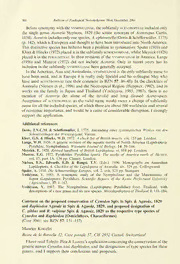
Comment On The Proposed Conservation Of Cynodon Spix In Spix & Agassiz, 1829 And Raphiodon Agassiz In Spix & Agassiz, 1829, And Proposed Designation Of C. Gibbus And R. Vulpinus Spix & Agassiz, 1829 As The Respective Type Species Of Cynodon And Raphiodon PDF
Preview Comment On The Proposed Conservation Of Cynodon Spix In Spix & Agassiz, 1829 And Raphiodon Agassiz In Spix & Agassiz, 1829, And Proposed Designation Of C. Gibbus And R. Vulpinus Spix & Agassiz, 1829 As The Respective Type Species Of Cynodon And Raphiodon
306 Bulletin ofZoological Nomenclature 58(4) December 2001 Before synonymywith thenymphulinae, the subfamilyacentropinae included only the single genus Acentria Stephens, 1829 (the senior synonym of Acentropus Curtis, 1834). Acentriaincludes onlyonespecies, A. ephemerella(Denis& Schiffermuller, 1775) (p. 142), which is European and thought to have been introduced into North America. This distinctive species has hitherto been a problem to systematists: Spuler (1910) and Kloet& Hincks (1972)placed it inthe subfamily schoenobiinae, whilst Meyrick (1928) placed it in the pyraustinae. In their revisions ofthe nymphulinae in America, Lange (1956) and Munroe (1972) did not include Acentria. Only in recent years has its inclusion in the subfamily nymphulinae been generally accepted. In theAmericas, Asia and Australasia, nymphulinaeis the only subfamilynameto have been used, and in Europe it is really only Speidel and his colleague Mey who have used acentropinae (see their comment in BZN 57: 46-48). In the checklists of Australia (Nielsen et al., 1996) and the Neotropical Region (Heppner, 1992), and in works on the family in Japan and Thailand (Yoshiyasu, 1985, 1987), there is no mention of Acentria (let alone of the invalid and long disused Acentropus). Acceptance ofacentropinae as the valid name would mean a change of subfamily name forall the included species, ofwhich there are about 500worldwide and several ofeconomic importance, and would be a cause ofconsiderable disruption. I strongly support the application. Additional references Denis, J.N.C.M. & Schiffermuller, I. 1775. Ankiindung eines systematischen Werkes von den Schmetterlingen der Wienergegend. Vienna. Kloet, G.S. & Hincks, W.D. 1972. A check list ofBritish insects, viii, 153 pp. London. Lange, W.H. 1956. A generic revision ofthe aquatic moths ofNorth America (Lepidoptera: Pyralidae, Nymphulinae). Wasmann Journal ofBiology, 14: 59-144. Meyrick, E. 1928. Revisedhandbook ofBritish Lepidoptera. vi, 914 pp. London. Munroe, E.G. 1972. Pyraloides: Pyralidae (part). The moths ofAmerica north of Mexico, vol. 13, part 1A. 134 pp. Classey, London. Nielsen, E.S., Edwards, E.D. & Rangsi, T.V. (Eds.). 1996. Monographs on Australian Lepidoptera, 4. Checklist ofthe Lepidoptera ofAustralia, xiv, 529 pp. Collingwood. Spuler, A. 1910. Die Schmetterlinge Europas, vol. 2. xvii, 523 pp. Stuttgart. Yoshiyasu, Y. 1985. A systematic study of the Nymphulinae and the Musotiminae of Japan (Lepidoptera: Pyralidae). Scientific Reports of the Kyoto Prefectural University (Agriculture), 37: 1-162. Yoshiyasu, Y. 1987. The Nymphulinae (Lepidoptera: Pyralidae) from Thailand, with descriptionsofanewgenusandsixnewspecies. MicrolepidopteraofThailand, 1: 133-184. Comment on the proposed conservation of Cynodon Spix in Spix & Agassiz, 1829 and Raphiodon Agassiz in Spix & Agassiz, 1829, and proposed designation of C. gibbus and R. vulpinus Spix & Agassiz, 1829 as the respective type species of Cynodon and Raphiodon (Osteichthyes, Characiformes) BZN (Case 3041; see 57: 151 157) Maurice Kottelat Route de la Baroche 12, Casepostale 57, CH-2952 Cornol, Switzerland I havereadToledo-Piza & Lazara's applicationconcerningtheconservation ofthe generic names Cynodon and Raphiodon, and the designation oftype species for these genera, and I support their conclusions and proposals.
